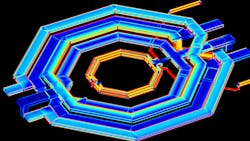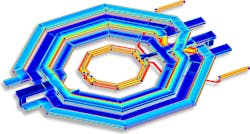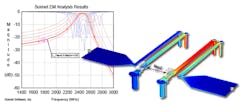Computer software simulators come in many varieties, tackling everything from passive circuit elements to full electronic systems. As a form of “thread” that ties them together, electromagnetic (EM) simulators show the EM fields generated by devices, circuits, and systems. They may do it in planar or two-dimensional (2D) form or in three dimensions (3D), showing EM fields in all three axes. EM simulators are ever-evolving, providing increased insights into electronic designs. As part of this evolution, they’re gaining in power as well as becoming easier to use, working more efficiently with other computer-aided-design (CAD) software.
Many EM simulators have been evolving for three or more decades and now take advantage of some of the luxuries of modern PC processing speeds and the ease of use provided by the latest graphical user interfaces (GUIs). In support of modern design efforts, many of the latest EM simulators can team with other CAD software programs, such as circuit and system simulators, for added power. For example, circuit element models created in an EM simulator can be imported into a circuit or system simulator to predict just what those models will do at the circuit and system levels.
EM simulators function by solving the equations bearing James Clerk Maxwell’s name. Those four coupled partial-differential equations describe the generation and propagation of magnetic and electric fields. They can calculate EM field strengths for different current and voltage conditions and analyze the effects of different transmission-line widths and materials, different circuit structures, and different dielectric materials. Furthermore, they’re able to analyze how changes to different material and structural elements will affect the expected performance of the structure or circuit.
Perhaps one of the strongest trends in the use of modern EM simulations, whether performed in 2D or 3D versions, is how many newer EM simulation programs can now operate in partnership with another simulation package, such as a circuit or system simulator. Such capability, for example, makes it possible to explore the electrical and thermal effects of a nonstandard dielectric or packaging material on the performance of a circuit element or component.
While material effects due to temperature changes are often associated with physical stress, they’re also typically responsible for variations in electrical performance. Especially at higher frequencies, a design that depends on tight amplitude and phase responses can be strongly impacted by amplitude and phase unbalance as a function of temperature. An EM simulator can reveal such concerns: By working in conjunction with, for example, a system simulator, the models developed within the EM simulator can be imported within the system simulator to compare the amplitude and phase matching of multiple channels in a radar system.
Evolving Power
Evidence of the multiple-decade lifespan of many EM simulation tools can be found in the latest version of Sonnet Software, which is currently available in v17. Not always the easiest program to use, it now enjoys a straightforward GUI that’s a result of user feedback and working within the limits of the Windows operating system (OS) to provide an interface that anyone with even a little experience in EM simulation can operate. It’s possible to modify design environments as needed to suit different workflows, and controls can be moved almost anywhere needed on the computer screen.
Sonnet has always been appreciated for its attention to detail (Fig. 1), and its capability to define minute structures such as sections of passive circuit elements and semiconductor ICs. This latest version of Sonnet Software is designed to perform EM simulations on its own as well as within the Advanced Design System (ADS) from Keysight Technologies, where EM models can be integrated within an ADS circuit or system simulation.
For example, a component like a filter or antenna that’s been simulated with the Sonnet Electromagnetic Co-simulation (SEC) capability can be integrated within an ADS circuit simulation to explore the effects of that component on a higher-level simulation, such as a receiver front end. By using SEC models within an expected performance range, production variations at the component level using a Sonnet EM simulation can be reflected in the final performance predicted by the ADS system-level simulations.
For its part, Keysight offers EM simulation software nominally for use with or without ADS. RFPro EM simulation software, which was developed for integration within its ADS software, can be used within ADS with little or no setup time. It provides the capability to study the EM behavior of shields, packages, and interconnections among a wide range of circuit structures while simulating a circuit or system within ADS. Design layouts are used as is within the ADS environment, without modifications needed to account for EM junctions. The typical setup time for RFPro in ADS is about one minute.
Keysight’s EMPro, on the other hand, offers much more extensive modeling features, although without the ease of use provided by RFPro’s integration into ADS. EMPro is capable of modeling and simulating EM effects from passive devices (e.g., inductors, capacitors) to full system levels like radars, although it requires much longer setup times to perform tasks such as defining model parameters. It has the functionality to create its own device and circuit layouts for EM simulations (where RFPro uses the layouts in ADS) and can export connector and package models into ADS, but they must be fully parameterized.
EMPro is equipped with full EM simulation capabilities based on finite-difference-time-domain (FDTD) and finite-element-method (FEM) simulation engines. It can perform 3D EM analysis of designs from component through complex system levels at frequencies well into the mmWave range. Keysight also offers PathWave EM design software with EMPro as its simulation core. The EM simulator is designed to work within the PathWave circuit simulator to study the EM effects of different components within a circuit design. It’s also available in a version that’s fully integrated with ADS.
HFWorks is a 3D EM simulator fully integrated within the SOLIDWORKS suite of software design tools from Dassault Systèmes’ SolidWorks Corp. It uses the FEM of EM analysis to study passive circuits and structures such as resonators, antennas, and interconnects. It’s designed to work seamlessly with SOLIDWORKS so that data for EM models needn’t be imported each time simulations run at system or circuit levels.
The Ansoft High-Frequency Structure Simulator (HFSS) from Ansys, one of the most widely used EM simulators for analysis of RF/microwave components, circuits, and systems, is a 3D EM simulator well-suited for analyzing high-frequency and high-speed electronic circuits and devices. It features an intuitive GUI for ease of use and integration with thermal, structural, and fluid-dynamics modeling tools, delivering a multiphysics approach to simulation.
The Ansys HFSS simulation suite of EM solvers is also designed to handle anything from a passive circuit element to a full radar- or communications-system analysis. The simulator features automatic meshing in which EM meshes can enclose the most irregularly curved and shaped surfaces for accurate predictions of the EM fields being produced around those surfaces. The software suite has become a proven tool for large-scale EM simulation challenges, especially at high microwave and mmWave frequencies, such as automotive radar systems. With generous computer memory, the software can draw upon saved simulation “scenes” in traffic and potential accident setups as part of the analysis of an automotive advanced driver-assistance system (ADAS) in a vehicle.
For less-complex 3D EM simulations, the WIPL-D software suite from WIPL-D employs method-of-moments (MoM) solvers to determine the EM fields around different types of metallic surfaces, as might be found in high-frequency antennas. It employs quadrilateral meshing techniques to surround a surface under analysis for high accuracy, but also employs adaptive meshing to achieve a practical solution in a short amount of analysis time for computer power available. As a result, WIPL-D software (Fig. 2) can be used to cover relatively large surfaces under simulation even when running on a standard PC.
As noted, the number of commercial EM simulators is on the rise, although not all are available fully integrated into circuit and system simulators. Remcom, for example, offers a trio of application-focused EM simulators that simplify the simulation of automotive and wireless experiments.
The firm’s Wireless Insite is so named for its capability of performing site-specific analyses on wireless networks, including all antennas, sensors, cables, and other interconnecting hardware. But this is really a system-level simulator that also can analyze radar system performance at all frequencies. The company’s XFdtd EM simulation software is well-suited not only for antenna design, but for ensuring that the antennas are optimally placed within a system design. The third EM software tool, Wayfarer, is designed to aid with radar simulation within ADAS vehicles.
Free Trials
As EM simulation becomes a more routine part of the RF/microwave design process, especially as a growing number of wireless communications and radar technologies reach well into the mmWave frequency ranges, more sources are developing and supporting EM simulators—whether for integration with circuit or system simulators or as standalone software tools. Engineers interested in exploring the capabilities of some of these tools can do so on a trial basis, free of charge. While these may not be full-power versions of the software, they provide the opportunity to examine the GUI, which can be as important as the accuracy of the EM calculations.
Sonnet Lite is a free version of the 3D EM simulator for analysis of planar structures such as coupled transmission lines (Fig. 3). It can be downloaded from the company’s website and even be integrated for use with multiple-function circuit and system simulators like ADS and Microwave Office from AWR (now part of Cadence). It’s one of many EM simulators available for no charge or free trial periods.
Autodesk, perhaps best known for simulation software to analyze construction sites, provides a 2D/3D CAD version of its modeling software as part of a free, 30-day trial period. Dassault Systèmes’ SolidWorks Corp. offers an online trial of its SOLIDWORKS 3D EM simulation software by creating a folder on the company’s website. The company also provides its CST Studio Suite and latest version (5.1) of its EM simulator for free download.
A review copy of the Ansys HFSS 3D EM simulation software is available for download from Software Informer in three steps, installing required software drivers for a particular PC and Microsoft Office OS. The highly accurate EM solver has been used at all levels, from devices to commercial/military communications and radar systems.
About the Author
Jack Browne
Technical Contributor
Jack Browne, Technical Contributor, has worked in technical publishing for over 30 years. He managed the content and production of three technical journals while at the American Institute of Physics, including Medical Physics and the Journal of Vacuum Science & Technology. He has been a Publisher and Editor for Penton Media, started the firm’s Wireless Symposium & Exhibition trade show in 1993, and currently serves as Technical Contributor for that company's Microwaves & RF magazine. Browne, who holds a BS in Mathematics from City College of New York and BA degrees in English and Philosophy from Fordham University, is a member of the IEEE.



